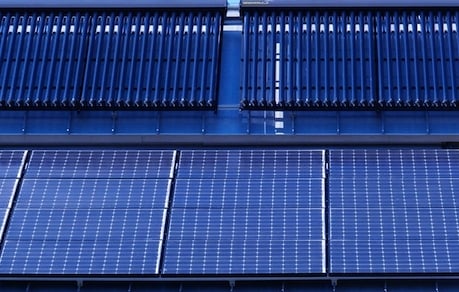J.M.Pearce (talk | contribs) (Created page with "{{MOST}} ==Source== ==Abstract== An exergy analysis was performed to compare a conventional (1) two panel photovoltaic solar thermal hybrid (PVT x2) system, (2) ...") |
J.M.Pearce (talk | contribs) mNo edit summary |
||
| Line 2: | Line 2: | ||
==Source== | ==Source== | ||
[[image:PV+ther.jpg|right]] M.J.M. Pathak, P.G. Sanders, [[J. M. Pearce]], [http://dx.doi.org/10.1016/j.apenergy.2014.01.041. Optimizing limited solar roof access by exergy analysis of solar thermal, photovoltaic, and hybrid photovoltaic thermal systems], ''Applied Energy'', 120, pp. 115-124 (2014). DOI: http://dx.doi.org/10.1016/j.apenergy.2014.01.041 [Open access soon] | |||
==Abstract== | ==Abstract== | ||
| Line 7: | Line 8: | ||
==Major Findings== | ==Major Findings== | ||
* Rigorous theoretical exergy model developed to compare solar energy systems. | |||
* Compared photovoltaic solar thermal hybrid (PVT) systems. | |||
* Also side by side photovoltaic and thermal (PV + T) systems. | |||
* Also photovoltaic (PV) systems and solar thermal (T) systems. | |||
* PVT systems are superior in exergy performance in representative climates. | |||
==See also== | ==See also== | ||
* [[Combined photovoltaic solar thermal systems (PVT) - literature review]] | |||
* [[High-temperature annealing pulses in amorphous silicon PVT]] | |||
* [[Amorphous silicon PVT]] | |||
[[Category:MOST completed projects and publications]] | [[Category:MOST completed projects and publications]] | ||
[[Category:Energy]] | [[Category:Energy]] | ||
Revision as of 23:41, 16 February 2014
Source

M.J.M. Pathak, P.G. Sanders, J. M. Pearce, Optimizing limited solar roof access by exergy analysis of solar thermal, photovoltaic, and hybrid photovoltaic thermal systems, Applied Energy, 120, pp. 115-124 (2014). DOI: http://dx.doi.org/10.1016/j.apenergy.2014.01.041 [Open access soon]
Abstract
An exergy analysis was performed to compare a conventional (1) two panel photovoltaic solar thermal hybrid (PVT x2) system, (2) side by side photovoltaic and solar thermal (PV + T) system, (3) two module photovoltaic (PV) system and (4) a two panel solar thermal (T x2) system with identical absorber areas to determine the superior technical solar energy systems for applications with a limited roof area. Three locations, Detroit, Denver and Phoenix, were simulated due to their differences in average monthly temperature and solar flux. The exergy analysis results show that PVT systems outperform the PV + T systems by 69% for all the locations, produce between 6.5% and 8.4% more exergy when matched against the purely PV systems and created 4 times as much exergy as the pure solar thermal system. The results clearly show that PVT systems, which are able to utilize all of the thermal and electrical energy generated, are superior in exergy performance to either PV + T or PV only systems. These results are discussed and future work is outlined to further geographically optimize PVT systems.
Major Findings
- Rigorous theoretical exergy model developed to compare solar energy systems.
- Compared photovoltaic solar thermal hybrid (PVT) systems.
- Also side by side photovoltaic and thermal (PV + T) systems.
- Also photovoltaic (PV) systems and solar thermal (T) systems.
- PVT systems are superior in exergy performance in representative climates.

